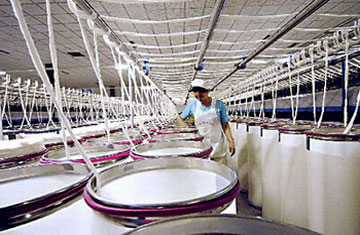 After the textile and apparel industry experienced steady growth in 2011-12, the slowdown in store growth, increase in terminal discounts, and slump rate will push the menswear industry into a new round of adjustment cycles. Brands and brands, sub-sectors and sub-sectors The major differentiation of the current round will be the most significant feature of the current round of adjustment, and the era of large-scale differentiation in the textile and clothing industry will come.
After the textile and apparel industry experienced steady growth in 2011-12, the slowdown in store growth, increase in terminal discounts, and slump rate will push the menswear industry into a new round of adjustment cycles. Brands and brands, sub-sectors and sub-sectors The major differentiation of the current round will be the most significant feature of the current round of adjustment, and the era of large-scale differentiation in the textile and clothing industry will come. The key points supporting the rating industry downturn, into the era of major polarization. The deteriorating profitability of dealers indicates that the menswear industry will enter a new round of adjustment cycles. From the conclusion of the men's and women's 13-year spring/summer trade fairs, the growth rate of domestic mainstream menswear companies' ordering sessions has dropped from a high of 20% to 30% in 12 years to a low double-digit or even single-digit level. Under the background of the slowdown of the industry, the difference in the brand operation model and the difference in the development stage of the sub-industry will lead to the differentiation of individual stock performance.
Mainstream menswear industry: cycle-driven performance. With the increase of channel penetration rate, the mainstream menswear industry will gradually enter the leading stage of the cycle. In the short term, we believe that the decline in terminal sales and the accumulation of channel inventory will push the industry into a new round of inventory deregulation. In terms of the industry life cycle, intensified brand competition in mature industries will lead to channel subsidy and marketing costs for brand owners. As a result, the profit rate of domestic men's wear returns to the international level in the long term.
High-end men's clothing industry: focus on the expansion opportunities in third and fourth-tier cities. The high-end men's clothing industry is in a period of rapid development. High- and middle-income people with wide distribution in third- and fourth-tier cities will provide broad space for channel sinking. According to the analysis of the target customer penetration rate, we expect that the leading enterprises in the industry will still have room to expand more than once. Rapid growth demand and a relatively modest competitive environment are expected to ensure the rapid growth of industry enterprises in the adverse market.
The main risk of rating The rapid increase in end-user consumption has led to faster-than-expected destocking in mainstream menswear channels.
The new supply of domestic commercial properties will reach a peak in 2012-14. If a large number of mature commercial properties are concentrated in the market, the supply and demand relationship between brands and channels may be reversed, resulting in a lower-than-expected decline in the net profit rate of mainstream menswear.
The model of department store deductions makes the impact of channel sinking on the leasing ratio not obvious. Therefore, if the efficiency of high-end men's brand new store marginal floor is too low, the fixed cost pressures such as renovations and labor can lead to lower-than-expected new store profitability.
Preferred purchase of Kanudi Road. The high-end men's clothing industry is in a period of rapid expansion. The rapid state expansion and co-store growth of leading companies in recent years indicate that the industry is still in the “supply-driven†development phase, during which rapid store expansion will be the lowest cost customer acquisition method. Kanudi Road, as an industry leader, is expected to capitalize on the rapid deployment of channels and the growth of the market.
Annunciation. Under the background of declining industry, dealer confidence has become the dominant factor in the mid-term performance of the brand. Among the mainstream menswear companies, the support of the Annunciation Channel is the highest, and the pressure on dealers' inventory is the lightest, so it is expected to be the first to recover from the destocking cycle.
Taking the advantange of the non stick and heat resistance of PTFE, also the strength and dimensional stability of fiberglass,our Non Stick BBQ Liner & Mesh Mats help you to avoid to put the food on dirty, burnt and rusty BBQ grill or plate directly,helps to keep BBQ grill clean, saves hard work to wash. Most important,there is no need to put oil or grease on the liner any more, so allows customers to bbq in a much healthier lifestyle. Both sides are reusable for years, easy to clean in soapy water with a sponge, or kitchen paper.We also provide Non Stick BBQ Grill Mats and Non Stick BBQ Grill Tray.

|

|
The General Characteristics is:
- 100% non-stick
- Reusable
- Heat resistant up to 260°C (500°F)
- Quick and convenient
- Eco-friendly
- Can be cut to size with scissors to fit any bbq
- Easy to clean in soapy water with a sponge, or kitchen paper
- Dishwasher safe
- Complies with food regulations,was approved by FDA,LFGB etc.
Non Stick BBQ Grill Liner & Mesh Mats
BBQ Grill Liner, BBQ Grill Mesh Mats,Non Stick BBQ Grill Liner, Non Stick BBQ Grill Mesh Mats,Non Stick BBQ Grill Mats,Non Stick BBQ Liner,Non Stick BBQ Grill Tray
NINGBO TIANSHUO (SUPERBRIGHT) TECHNOLOGY CO. LTD., , https://www.ptfe-supplier.com